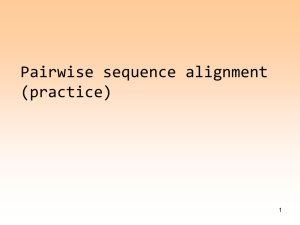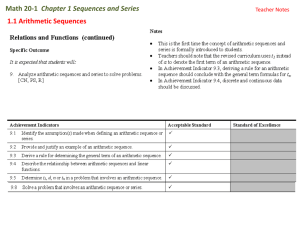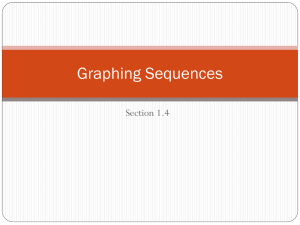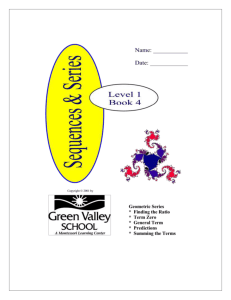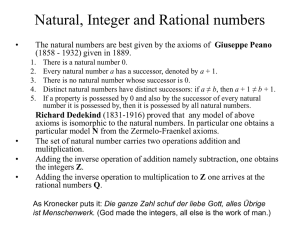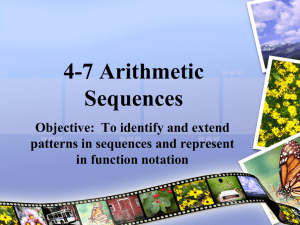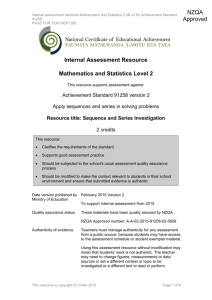1_7 Patterns and Sequences Notes
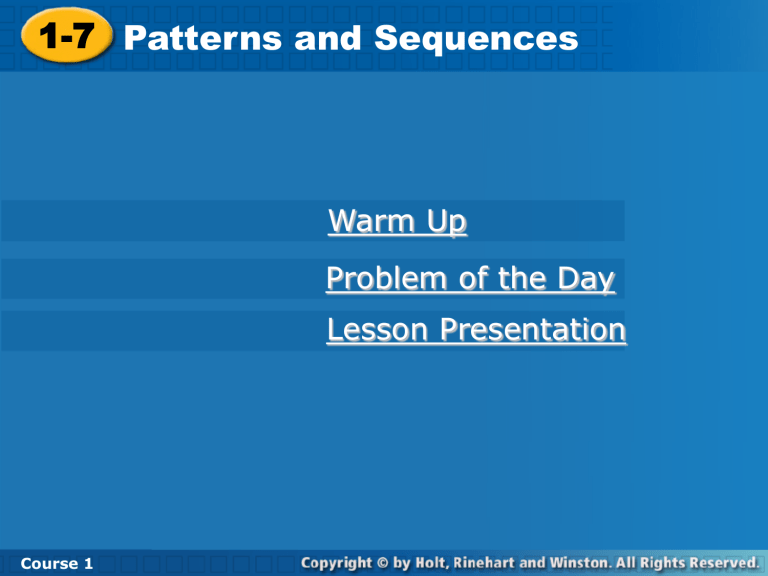
1-7 Patterns and Sequences
Warm Up
Problem of the Day
Lesson Presentation
1-7 Patterns and Sequences
Warm Up
Determine what could come next.
1. 3, 4, 5, 6, ___
2. 10, 9, 8, 7, 6, ___
3. 1, 3, 5, 7, ___
4. 2, 4, 6, 8, ___
5. 5, 10, 15, 20, ___
7
5
9
10
25
Course 1
1-7 Patterns and Sequences
Learn to find patterns and to recognize, describe, and extend patterns in sequences
.
Course 1
1-7 Patterns and Sequences
Vocabulary
perfect square term arithmetic sequence
Course 1
1-7 Patterns and Sequences
Each month, Eva chooses 3 new DVDs from her
DVD club.
Eva’s DVDs
Position Month DVDs Value
3
4
1
2
3
6
9
12
+ 3
+ 3
+ 3
The number of DVDs Eva has after each month shows a pattern: Add 3. This pattern can be written as a sequence.
3, 6, 9, 12, 15, 18, …
Course 1
1-7 Patterns and Sequences
A sequence is an ordered set of numbers. Each number in the sequence is called a term. In this sequence, the first term is 3, the second term is
6, and the third term is 9.
When the terms of a sequence change by the same amount each time, the sequence is an
arithmetic sequence.
Course 1
1-7 Patterns and Sequences
Helpful Hint
Look for a relationship between the 1st term and the 2nd term. Check if this relationship works between the 2nd term and the 3rd term, and so on.
Course 1
1-7 Patterns and Sequences
Additional Example 1A: Extending Arithmetic
Sequences
Identify a pattern in each sequence and then find the missing terms.
48, 42, 36, 30, , , , . . .
–6 –6 –6 –6 –6 –6
Look for a pattern. A pattern is to subtract 6 from each term to get the next term.
30 – 6 = 24 24 – 6 = 18 18 – 6 = 12
So 24, 18, and 12 will be the next three terms.
Course 1
1-7 Patterns and Sequences
Additional Example 1B: Extending Arithmetic
Sequences
Position
Value of Term
1 2 3 4 5 6
9 22 35 48
+13 +13 +13 +13 +13
A pattern is to add 13 to each term to get the next term.
48 + 13 = 61 61 + 13 = 74
So 61 and 74 will be the next terms in the arithmetic sequence.
Course 1
1-7 Patterns and Sequences
Check It Out: Example 1A
Identify a pattern in each sequence and name the next three terms.
39, 34, 29, 24, , , , . . .
–5 –5 –5 –5 –5 –5
Look for a pattern. A pattern is to subtract 5 from each term to get the next term.
24 – 5 = 19 19 – 5 = 14 14 – 5 = 9
So 19, 14, and 9 will be the next three terms.
Course 1
1-7 Patterns and Sequences
Additional Example 2A: Completing Other
Sequences
Identify a pattern in the sequence. Name the missing terms.
24, 34, 31, 41, 38, 48, , , ,…
+10 –3 +10 –3 +10 –3 +10 –3
A pattern is to add 10 to one term and subtract 3 from the next.
48 – 3 = 45 45 + 10 = 55 55 – 3 = 52
So 45, 55, and 52 are the missing terms.
Course 1
1-7 Patterns and Sequences
Additional Example 2B: Completing Other Sequences
Position 1 2 3 4 5 6 7 8
Value of Term 1 4 2 8 16 32
4 ÷2 4 ÷2 4 ÷2 4
A pattern is to multiply one term by 4 and divide the next by 2.
8 ÷ 2 = 4 4 4 = 16 16 ÷ 2 = 8 8 4 = 32
So 4 and 8 will be the missing terms in the sequence.
Course 1
1-7 Patterns and Sequences
Check It Out: Example 2B
Position 1 2 3 4 5 6 7 8
Value of Term 1 6 3 18 54 162
6 ÷2 6 ÷2 6 ÷2 6
A pattern is to multiply one term by 6 and divide the next by 2.
18 ÷ 2 = 9 9 6 = 54 54 ÷ 2 = 27 27 6 = 162
So 9 and 27 will be the missing terms in the sequence.
Course 1


